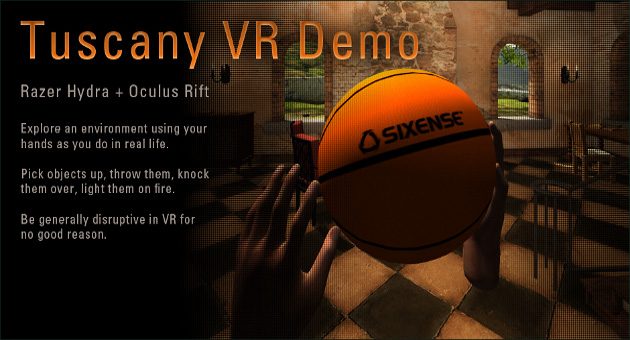Sixense, developers of the Razer Hydra, have officially released the Razer Hydra enabled ‘Tuscany’ demo that Ben had an exclusive hands-on with at GDC just a few weeks ago. The demo is a heavily customised version of the ‘Tuscany’ demo supplied as part of the Oculus SDK (Software Development Kit) which adds Hydra support and provides one of the most compelling VR experiences for the Oculus Rift yet seen.
The Oculus Rift and Razer Hydra’s Current ‘Killer App’
Sixense have announced the release of the Demo which our very own Ben described as “hands-down the most fun I’ve had in virtual reality yet.” and has since become a minor sensation in the VR community.
Download Oculus Rift Razer Hydra Tuscany Demo Here
Staff at Sixense’s own forum had recently stated that the demo would be released on Monday, but it later failed to appear. Sixense have told us that this delay was simply to ensure that any potential differences between the ‘Partner Preview‘ Oculus Rift HMDs they’d used to develop the demo and the final Developer Kit (now shipping) would not cause any compatibility or user experience issues.
Sixense tells us that they hope to release the source code for the level so that developers can take advantage of the work that’s been done, but there are still some logistics to work out on that front.
New Features
Those who don’t yet have their hands on the Oculus Rift but do have a Razer Hydra will be able to get in on the action too. The demo will detect whether or not the Rift is detected. If not you’ll get a standard view. If so, you’ll get proper 3D and warping.
This public release demo includes some additional features, one of which is a 3D interactive menu which can be controller via your virtual hands, overlaid on the gameworld. The new menu exposes various new settings that can be adjusted by the user:
Arm Length: Three options are available to change how far you can reach with the virtual arms
Longest – You can reach everything with ease. The reach distance is almost 2:1.
Long – Reach just a little further. Reach distance is 1.25:1
1to1 – Hand position matches your physical hand position
Crouching: If enabled, lowest position of either Hydra controllers will determine your crouch height. Use the plank and crouch walk through the window. This feature is needed when using the Arm Length option is set to 1 to 1 so that you can reach the ground.
Head Bob: This is disabled by default as can enhance nausea. Enable this to remove the wheels.
Crosshair: A 3d crosshair is rendered depicting your forward direction. This can be useful in helping to see that your forward direction has drifted. Use the Left Start button while facing forward reset your forward direction.
Ben said of his time with the demo:
Interacting with the Tuscany demo using the Razer Hydra was not only natural — it was fun! Reaching out and touching objects with your own virtual hands is miles more immersive than using a keyboard and mouse. You can do things with the Rift and the Hydra that you simply can’t do with a monitor and traditional input.
Razer Hydra Unity and UDK Plugins
For developers working with the Oculus Rift in Unity, Sixense has available a Razer Hydra plugin which provides code to start working with the Hydra. Two modes will help you get up and running — one which reads out all of the data from the controllers, and another which actually gives you a working hand demo similar to the one found in the Tuscany demo. Sixense tells us that Mac support for the plugin is on the way.
Download the Razer Hydra Unity Plugin Here
The company tells us that they’re also working on a Razer Hydra UDK plugin. Once complete they’ll have full support on both major Oculus Rift compatible game engines. They’ve shared this early prototype of their UDK Hydra implementation:








